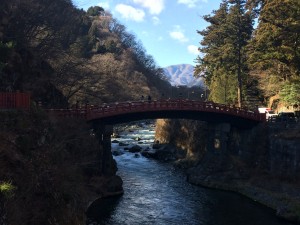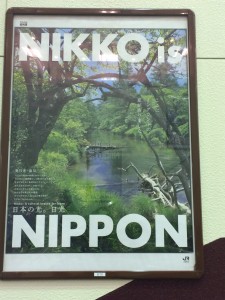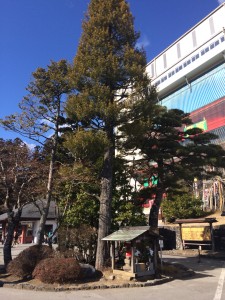
We took a day off from our daily farm work in ARI as we continue to travel around Japan. This time we visited Nikko, one of the World Heritage Sites. We were excited to visit shrines and temples. My expectations in Nikko is different from what I actually see. What I anticipated in Nikko is seeing shrines in their natural setting that is untouched by humans. In reality, some of the shrines are constructed inside of buildings which I did not expect this at all. While I did enjoy the trip to Nikko, I was intrigued how Nikko is considered as a natural park by the World Heritage Sites committee. I was also wondering why the park rangers shape Nikko in specific ways (i.e man made waterways, lakes, rocks) to convey the place as “natural” to the visitors.


As we traveled through the train stations, we saw posters advertising Nikko with tranquil backgrounds of trees, rivers and mountains. What’s really interesting is the posters don’t directly advertise shrines and temples in English despite that this is Nikko’s main attraction for both tourists and Japanese people. Instead, the posters emphasize Nikko as an ideal place where people can experience and appreciate the aesthetics of nature. The posters also emphasize that one can be in tune with nature just from visiting the site.
One of the posters is written in English “A cultural beacon for Japan” to tell the visitors that Nikko is an cultural and historical place for Japan while the rest of the paragraph is in Japanese. The Japanese text describes Nikko and romanticizes the place with descriptions of sunlight and mountains. Along with that, the description also refers to Japan’s traditional practices of worshiping gods and the location of Nikko.
The descriptions of the posters are in different languages and I believe this is intentional because the non Japanese and the Japanese people have different perspective on what Nikko means for them. For the Japanese people, they visit Nikko because they associate the place with their national identity. The shrines in Nikko reflect their rich culture and history. For the visitors, they associate Nikko as a representation of Japan’s culture and history and Japanese’s perspective in nature.
After we rode on the bus, we saw a beautiful waterfall and a bridge. The sight is breathtaking and it’s a perfect place to take pictures. We went up the stairs to the shrines and the first shrine we visited was inside the building. The entrance of the “shrine” is decorated with the painting of the shrine.

The shrine is being constructed in the internal parts so the building serves as an external protection for the statues. Unfortunately, we were not allowed to take photos inside the shrine so I was not able to take pictures of the Shinto gods. While we visited more shrines, I noticed that the small trees are pruned so all of the trees are uniform to give off the sense that it’s natural. Even the trees near the parking lot are purposely placed to convey the sense of harmony to the visitors. This made me think: To what extent can we consider man made materials as part of nature? What is our relationship with nature?

Despite that shrines and the guardian lions are man made, we perceive them as part of nature without a second thought since it has significant cultural meaning to Japan. What’s interesting is that I have to challenge my instinct of passing off shrines as part of nature while if there’s an arcade machine in Nikko, I would immediately able to distinguish the machine as separate from nature. It’s more difficult to distinguish man made materials if they blend easily with nature. For example, as I walk down the stairs to the exit, I noticed that the sound of a river running. However, the “river” is constructed by the stairs and it took me awhile to identity the “river” as man made since I immediately associated running water as part of nature.
To answer the first question, “To what extent can we consider man made materials as part of nature?” we should consider our interaction with nature and how it integrates with our culture. For Japanese culture, their culture is often associated with harmony and peace by people who are not familiar with Japanese culture. How humans achieve the qualities of peace and harmony in their culture is through constructing buildings and statues that reflect off these qualities and blend with nature well. The shrines and guardian lions blend with nature because both of the man made materials are symmetrical and have cultural significance to the Japanese. The shrines are used to practice Shinto, a religion that is associated with people’s interactions with nature. In short, we consider man made materials as part of nature if they are used to either help people have a closer relationship with nature spiritually or have cultural significance that is related to nature.
The second question “What is our relationship with nature”, Nikko demonstrates how human interaction with nature is beneficial. Nikko helps the Japanese to identity their own nationality. For the Japanese, Nikko is not just a natural park, but it is also part of their nationality identity. The shrines and statues serve as a reminder of their culture and their relationship with nature. Another way how the site benefits humans is Nikko helps them to remember that they are constantly surrounded by nature and Nikko prevents them from being completely alienated with nature. Even if the majority of the Japanese live in urban areas, they can still connect themselves with nature through the shrines that are built in the cities.
Overall, I have a great time in Nikko and Nikko may appear as a cultural landmark at first sight, but it’s more than a World Heritage Site. Rather, Nikko is a place where it reflects the complex relationship between human interactions and nature. Through manipulating nature, humans can reconstruct land and redefine nature up to the point where the the boundary between natural and man-made materials are difficult to distinguish.

Recent Comments